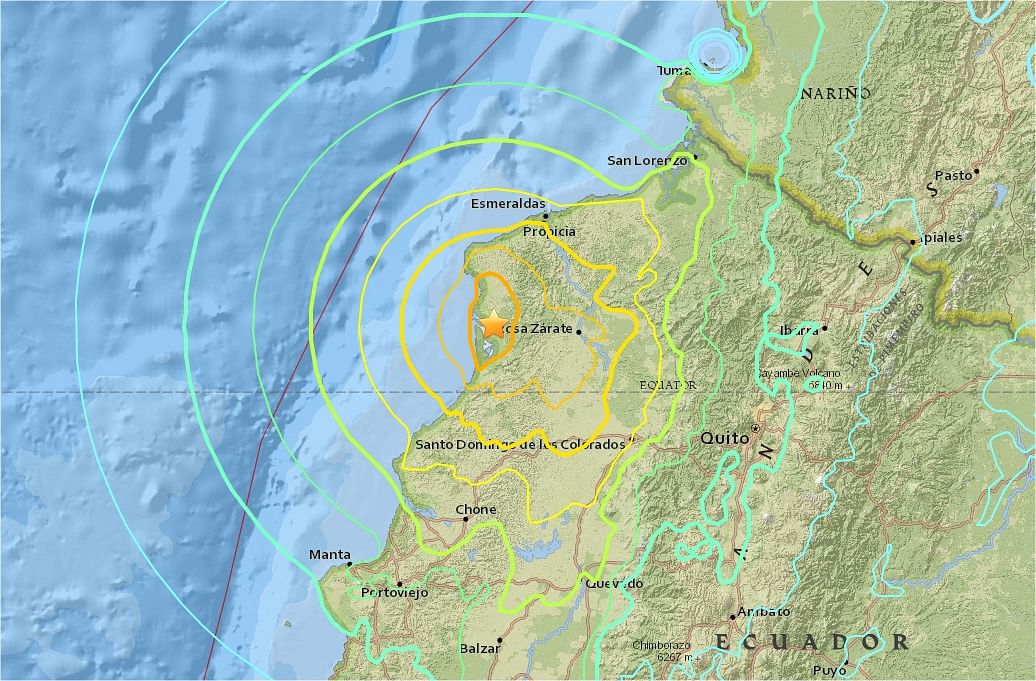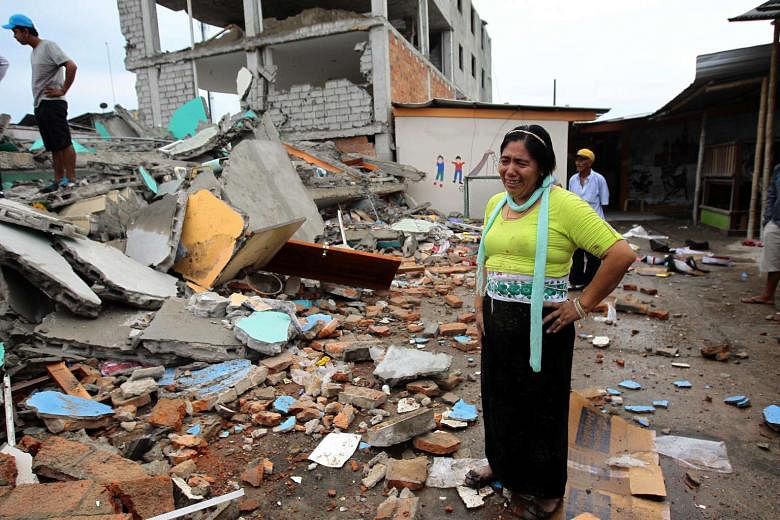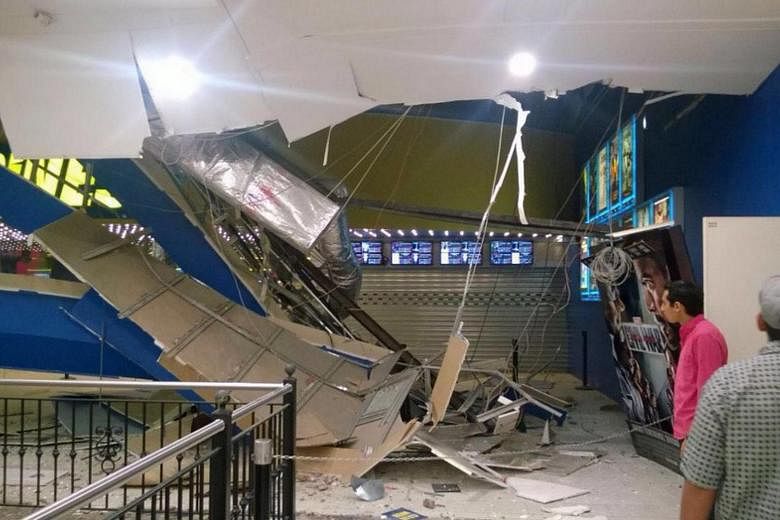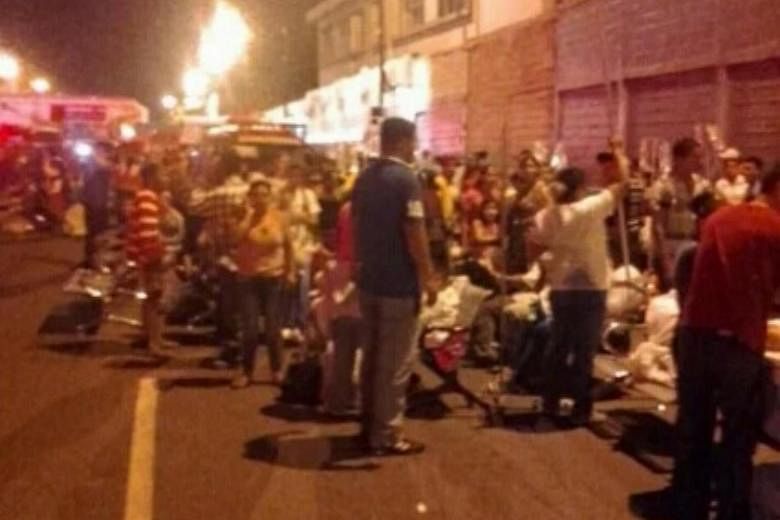QUITO (AFP, REUTERS) - The death toll from Ecuador's biggest earthquake in decades soared to at least 235 on Sunday as rescuers using tractors and bare hands hunted desperately for survivors in shattered coastal towns.
The 7.8 magnitude quake struck off the Pacific coast on Saturday and was felt around the Andean nation of 16 million people, causing panic as far away as the highland capital Quito and collapsing buildings and roads in a swathe of western towns.
President Rafael Correa, who was rushing home from a trip to Italy, said the confirmed number of fatalities rose on Sunday to 233.
"The immediate priority is to rescue people in the rubble,"he said via Tiwtter. More than 1,500 people were injured, authorities said.
Coastal areas nearest the quake were worst affected, especially Pedernales, a rustic tourist spot with beaches and palm trees. Information was scant from there due to poor communications and transport chaos.
"There are villages that are totally devastated," Pedernales' Mayor Gabriel Alcivar said in a radio interview."What happened here in Pedernales is catastrophic."
A state of emergency was declared in six provinces.
"There are people trapped in various places and we are starting rescue operations," Vice President Jorge Glas said on Sunday morning before boarding a plane to the area. He said in televised comments earlier that it was the strongest quake to hit Ecuador since 1979.
President Correa declared a national emergency and urged the Andean nation's 16 million people to stay calm. "Our infinite love to the families of the dead," he said on Twitter, while cutting short a trip to Italy to return home.
With a depth of 10km, the quake struck at 11.58pm GMT (7.58am Sunday, Singapore time) about 173 km west-north-west of Quito and just 28km south-south-east of Muisne, the USGS said.

The USGS said the quake had a magnitude of 7.8, though Ecuador's Institute of Geophysics on its Twitter account published several different figures that were lower.
The Hawaii-based Pacific Tsunami Warning Centre initially issued a warning for the nearby Pacific coastline, but later said that the threat had largely passed.
Pictures provided by the government showed a bridge collapsed in the coastal city of Guayaquil and a collapsed tower at the airport in the city of Manta.
"There is considerable damage in the area of the epicenter and also as far away as places like the city of Guayaquil," the Geophysics Institute said in a bulletin, but gave no details.
The government said the damage was "serious", especially in the western coastal areas nearest the quake and in Guayaquil.
Guayaquil's mayor Jaime Nebot, who was traveling in Spain, said on his Facebook page he would coordinate recovery operations from where he was.
Official details on the damage to Guayaquil, a frequent departure point for foreign tourists visiting the Galapagos islands made famous by Charles Darwin, were slow to emerge.
The Andean nation's government recommended residents leave coastal areas over concern for rising tides following the quake.
In fact, two earthquakes jolted the same area just 11 minutes apart, the USGS said. The first measured 4.8 and the second 7.8. Earlier reports had put the magnitude of the second quake at 7.4.
The quake sent confused residents streaming into the streets of Quito and spurred warnings of strong waves on the Andean nation's coast.
"I was in my house watching a movie and everything started to shake. I ran out into the street and now I don't know what's going to happen," said Ms Lorena Cazares, 36, a telecommunications worker in Quito.
Some parts of the capital were without power or telephone service, with many communicating only via What'sapp. Photos on social media showed cracks in the walls of shopping centers.
The capital's municipal government later said power had been restored and there were no reports of casualties in the city.
"At first it was light, but it lasted a long time and got stronger," said Ms Maria Jaramillo, 36, a resident of Guayaquil, describing windows breaking and pieces falling off roofs. "I was on the seventh floor and the light went off in the whole sector, and we evacuated. People were very anxious in the street ... We left barefoot."
"It was terrifying, we were all scared and we're still out in the streets because we're worried about aftershocks," said Guayaquil security guard Fernando Garcia. "Everything is damaged."
In northern Quito, people ran out of their homes frightened, as power lines swayed back and forth and cables danced.
"Oh, my God, it was the biggest and strongest earthquake I have felt in my whole life. It lasted a long time, and I was feeling dizzy," said Ms Maria Torres, 60, in the capital Quito, where people fled their homes during Saturday evening's quake. "I couldn't walk... I wanted to run out into the street, but I couldn't."
Ms Cristina Duran, 45, grabbed her three pets and stood under a large doorway to avoid shards of glass falling from shattered windows. "I was frightened. And I just kept asking for it to be over," she told AFP.
Mr Ramon Solorzano, 46, a car parts merchant in the city of Manta, said he was getting ready to leave the city with his family. "Most people are out in the streets with backpacks on, heading for higher ground," he said, speaking in a trembling voice via a WhatsApp phone call.
"The streets are cracked. The power is out and phones are down."
The authorities closed the airport in the western city of Manta, saying the control tower suffered "severe damage".
At the Guayaquil airport, passengers awaiting flights dashed out of terminals when they felt the shaking.
"Lights fell down from the ceiling. People were running around in shock," said Mr Luis Quimis, 30, who was waiting to catch a flight to Quito.
Ecuador's 110,000 barrel-per-day Esmeraldas refinery was halted as a precautionary measure after an earthquake, Mr Pedro Merizalde, head of state oil company Petroecuador told Reuters.
Crude production in Opec's smallest member was not, however, affected, other state oil officials said.
Quakes also rattled northern Peru and southern Colombia, according to authorities in those countries, although no casualties were reported. Peruvian officials however urged coastal residents to stay away from the beach.
Ecuador lies near a shifting boundary between tectonic plates and has suffered seven earthquakes of magnitude-7.0 or higher in the region of Tuesday's quake since 1900, the USGS said. One in March 1987 killed about 1,000 people, it said.
The major jolt came as rescuers in Japan were racing against the weather and the threat of more landslides to reach people still trapped by two big earthquakes that hit that country's south.
At last 41 people are known to have died in the double disaster, with at least six still missing - feared buried in shattered houses or under torrents of mud.






